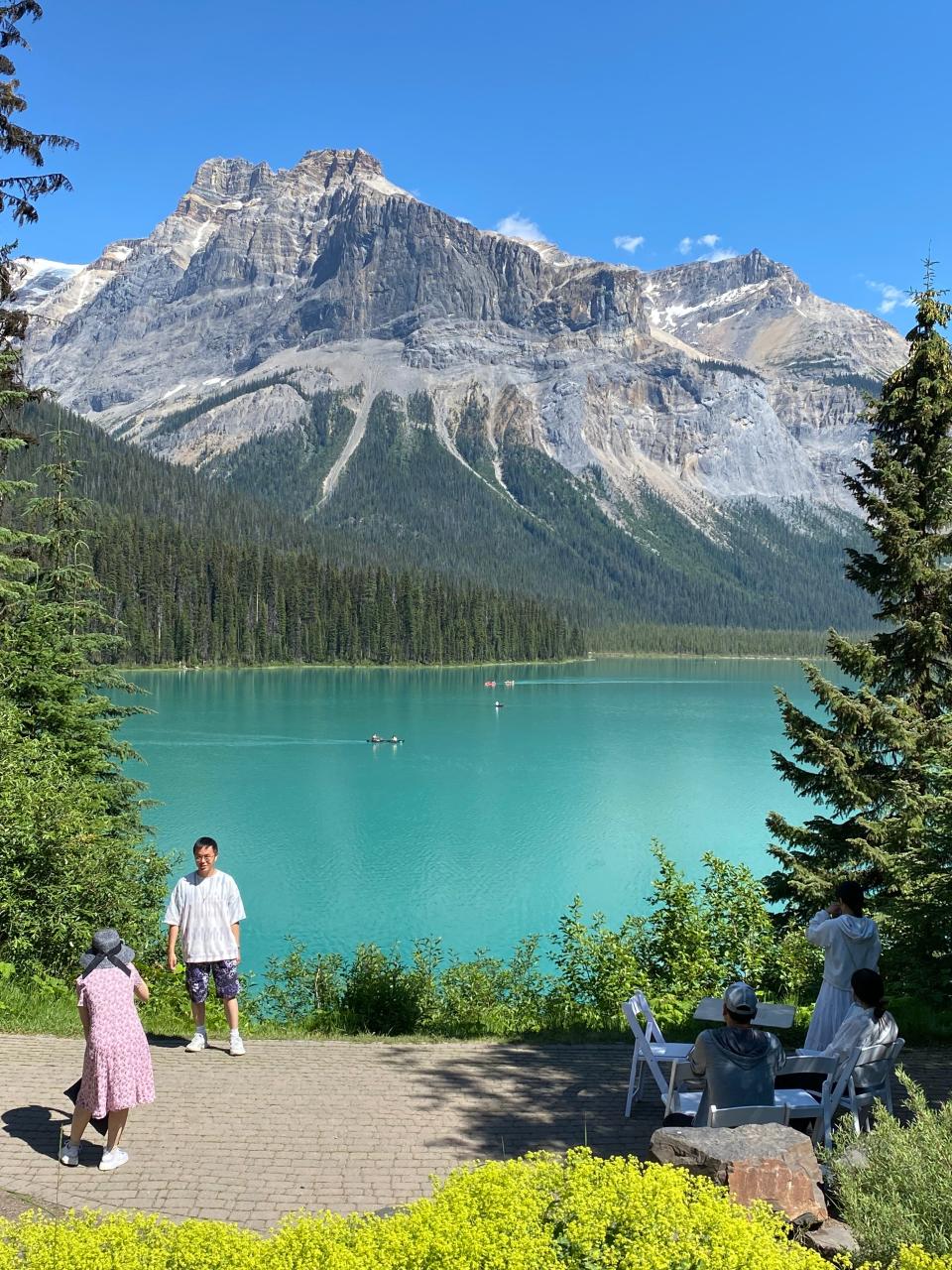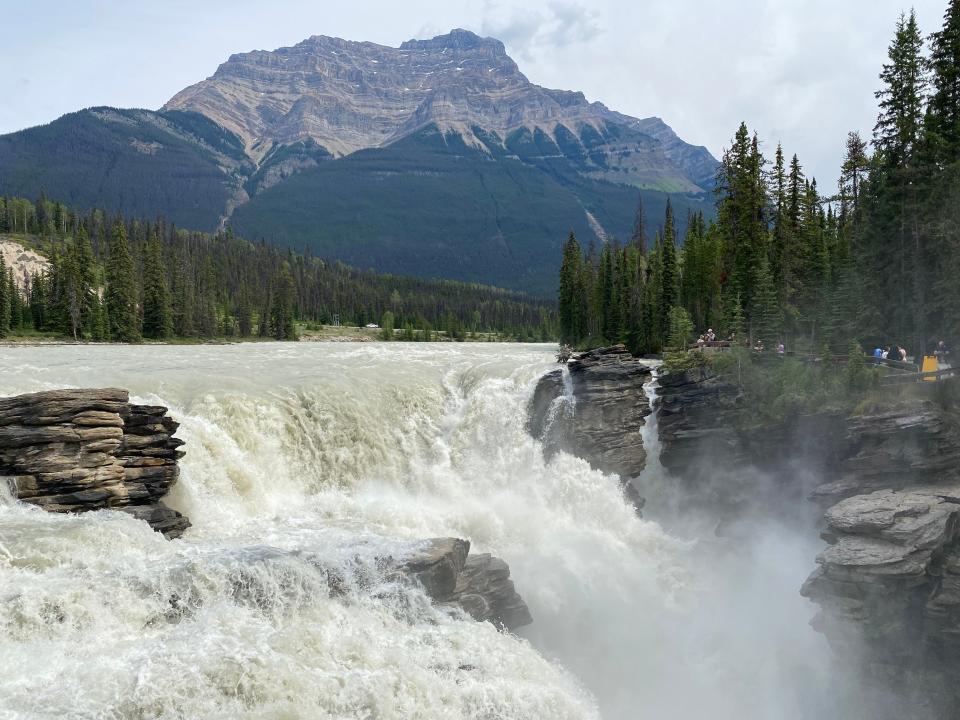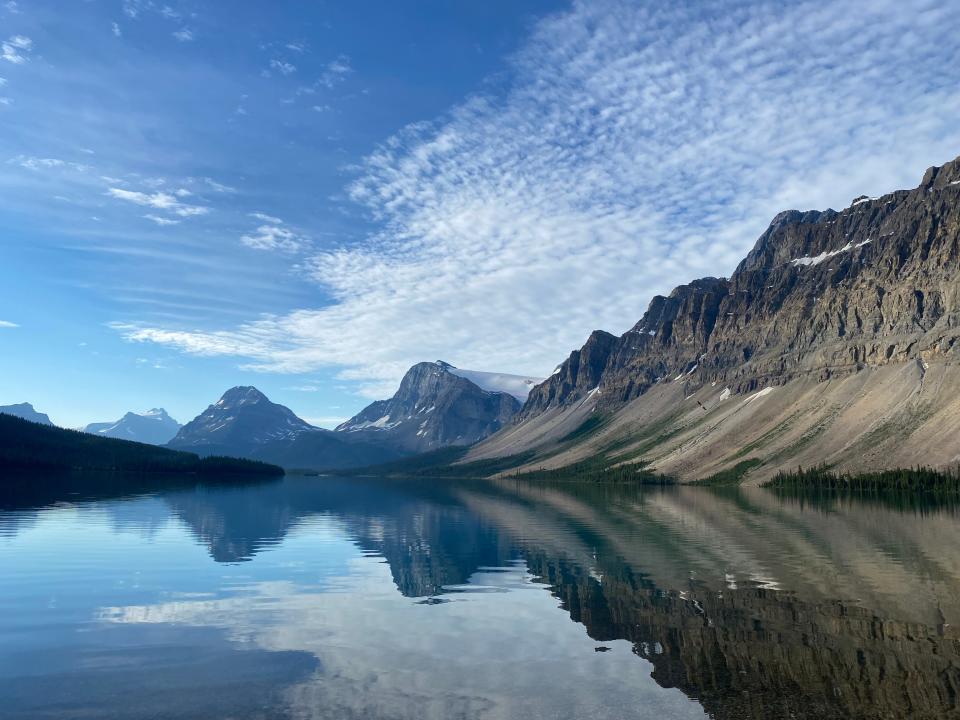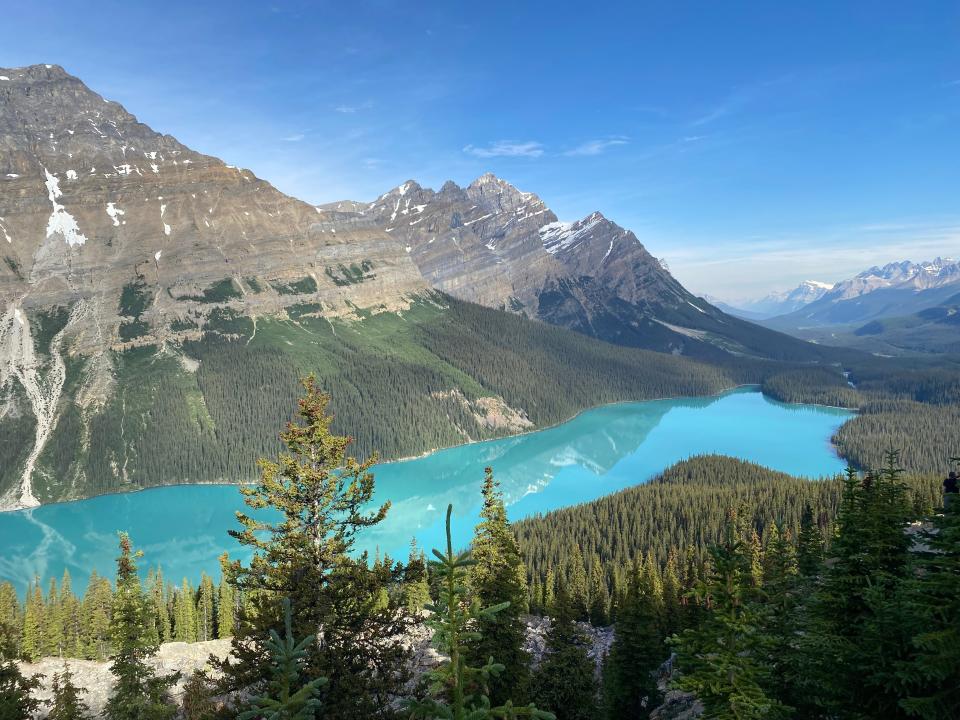Travel: The Canadian Rockies offer views you won't see anywhere else
BANFF, Alberta – The Canadian Rockies demand to be seen and shared. Saturated in primary colors, people race to take pictures for their Instagram accounts. No filters are needed. The colors dazzle the eye in the crystal-clear alpine air. Red canoes on turquoise lakes. Deep, blue skies framing snow-capped mountains. River cascades sparkling like diamonds. Wildflowers in rainbow hues.
Southern Alberta and British Columbia offer views that cannot be experienced elsewhere. Elk can be seen crossing the road or moose grazing at the lake’s edge. Visitors text pictures from restaurants in Banff, Lake Louise and Jasper.
Resort towns and national parks abound along the Icefields Parkway. For almost 150 miles, the scenic highway from Lake Louise to Jasper curves below magnificent mountain ranges and past rampaging waterfalls, dense forests and alpine meadows. Banff is Canada’s oldest national park, established in 1885. Jasper, at 4,247 square miles, is the largest national park in the Canadian Rockies. Equally stellar are Kootenay and Yoho national parks.
Travel: Drink in the beauty of Glacier National Park at the Many Glacier Hotel
Previously: Nature defines western New England, from Lake Champlain to the Berkshires
Banff and Lake Louise

The jumping-off point for the Canadian Rockies is Banff, located 80 miles west of Calgary. This town lies within Banff National Park and is internationally known for its ski resort and grand hotels. Summer visitors are a mix of families, bikers, college students and outdoor adventurers. Banff Avenue, a part of which is pedestrian-only, is at the center of an entertainment district that encompasses restaurants, brew pubs, hotels, hostels, shops and art galleries.
The exclusive Fairmont Banff Springs Hotel sits up the hill apart from the commotion. People stroll along the Bow River and meander through the Cascade of Time Gardens where flowers bloom in terraced beds.
Lake Louise, a hamlet about 20 miles northwest of Banff, has the lively vibe of Banff but on a much smaller scale. The Fairmont Chateau Lake Louise rises above the stream of visitors. The spectacular aqua blue lake reflects Mount Victoria and its massive glacier.
For quieter accommodations, travelers choose Paradise Lodge and Bungalows where they immerse themselves in the mountain setting. The Station Restaurant at the historic Lake Louise Railway Station serves delectable meals and spirits.
From Banff and Lake Louise, it’s a short drive to the wondrous natural attractions of the national parks. The Johnston Canyon Trail in Banff National Park features many catwalks that follow Johnston Creek, a roaring mountain stream that cuts through a deep gorge and creates impressive waterfalls. Seven bridges cross the swift-moving creek on the Marble Canyon Trail in Kootenay National Park. Emerald Lake in Yoho National Park lives up to its name. Visitors behold the deep-green water at this paddler’s paradise.
Icefields Parkway

Motorists hop on the Icefields Parkway at its southern terminus in Lake Louise and begin their journey northward. The 143-mile motor route, which parallels the Continental Divide, has frequent scenic overlook pull-offs, picnic grounds and trailheads to more than 30 hiking paths. Serious photographers find a wealth of subject matter in this natural dreamscape.
Visitors make stops at Bow Lake for views of Crowfoot Mountain, and then at the Peyto Lake Overlook, where they snap pictures of the bright turquoise lake, one of Canada’s iconic scenes. Mistaya Canyon produces similarly gasp-inducing moments. Under a brilliant blue sky, a thundering river drops into a limestone slot canyon flanked by deep green forests and Mount Sarbach.

Mount Wilson provides the backdrop at the Saskatchewan River Crossing, a junction of three rivers. Backpackers stop at the visitor center for maps, supplies and advice. A stunning view of the Saskatchewan Glacier rewards intrepid hikers on the 2.8-mile Parker Ridge Trail, considered one of the most worthwhile hikes in the area.
Near the midpoint of the Icefields Parkway, the Columbia Icefield stretches across 125 square miles. This remnant of the last ice age is the largest icefield in the North American Rockies. The Icefields Centre overlooks Athabasca and Dome glaciers, two of the eight glaciers making up the icefield. The visitor complex offers a film, exhibits and interpretive programs.
Otherworldly, the Columbia Icefield attracts people eager for a firsthand experience with a glacier. Adventurers ride the red Ice Explorer all-terrain vehicle to the Athabasca Glacier, then disembark to walk on the frozen surface. Others opt to hike and rock-hop over small streams to reach the glacier’s fringe. Wind, chilled by the icy landscape, whips down from the mountains, leaving hikers shivering in their shorts.
The Columbia Icefield feeds the Sunwapta River. The rest stop at Sunwapta Falls is a two-for-one deal: one waterfall is right off the parking lot and the other one is a half-mile walk along the cliff. In the native language, Sunwapta means turbulent river. These raging waters join the Athabasca River and create Athabasca Falls, a union of sheer drama. Water rumbles over wide rocks, then plunges 75 feet, and races through a narrow gorge.
For those seeking quiet after experiencing rampaging rivers, the answer awaits near the end of the Icefields Parkway in the Valley of the Five Lakes. An easy, 3-mile footpath wraps around hidden lakes in a lush, verdant forest.
Travel: From Gilded Age mansions to FDR's picnics, Hudson Valley captures pastoral state of mind
More: Nature defines western New England, from Lake Champlain to the Berkshires
Jasper

A herd of elk serves as a welcoming committee for motorists as they reach Jasper, the northern terminus of the Icefields Parkway. The elk feed on grass and wildflowers along the roadside and cross the road at their leisure.
In Jasper, motorists shake off their road weariness and hikers shed trail dust. They recount the day’s events over Crisp Pils beers and plates of fish and chips. Patrons look out on the rail yard and Athabasca River. Other restaurants and shops line Connaught Drive and Patricia Street. The search for a golden sunset leads to Pyramid Island. It’s a romantic walk over a wooden bridge to a peaceful hideaway.
Jasper originated as a fur trade outpost before transitioning into a railroad town. With the growth of tourism in the national parks, Jasper evolved into a year-round base camp for adventure.
Close-up animal sightings are almost expected at Maligne Lake, where inhabitants include bighorn sheep, mountain goats and bears. Finely chiseled mountains circle the lake’s azure water and Spirit Island, a classic experience on many people’s bucket lists.
The Jasper SkyTram to the top of Whistlers Mountain provides 50 miles of visibility on a clear day. Peaks rake the sky. People marvel at the wilderness panorama and photograph the soul-stirring beauty.
Linda Lange and Steve Ahillen are travel writers living in Knoxville, Tenn.
This article originally appeared on Knoxville News Sentinel: The Canadian Rockies in Southern Alberta, British Columbia
